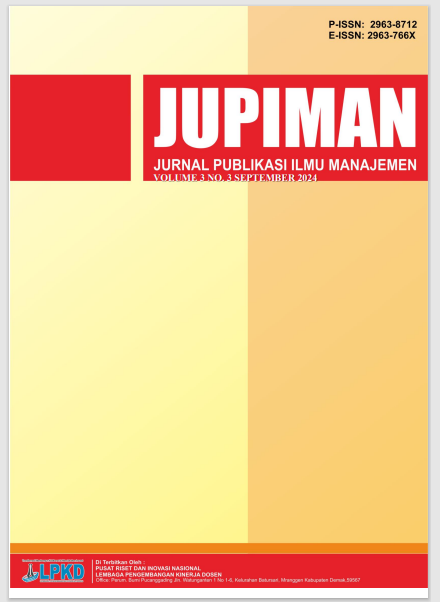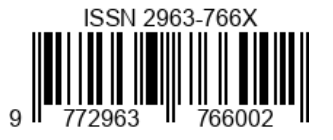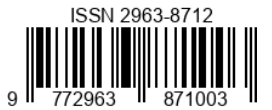Pengaruh Reward dan Punishment terhadap Kinerja Karyawan PT Ruijin Trade Indonesia Jaya
DOI:
https://doi.org/10.55606/jupiman.v4i1.4902Keywords:
Reward, Punishment, and Employee PerformanceAbstract
Based on various literatures, reward can be understood as an award or reward given by an organization to its members, either in the form of financial, nonfinancial, or psychological material. This study aims to determine the influence of Reward and Punishment on Employee Performance of PT Ruijin Trade Indonesia. The data collection method for this study is the interview and questionnaire method, and the data analysis uses quantitative analysis. Based on the results of the T test that was conducted, the sig value was 0.014 from the T table value of 2.037, it was concluded that Punishment had a partial influence on employee performance. Based on the results of the F test conducted, the sig value is 0.000 the F table value is 4.149, so it is concluded that Reward and Punishment have a simultaneous influence on employee performance. Based on the results of the determination coefficient test (simultaneous) it shows that it is concluded that Reward and Punishment have an effect of 80%, while 20% is influenced by other variables that are not studied.
Downloads
References
Adityarini, C. (2022). Pengaruh Reward dan Punishment Terhadap Kinerja Karyawan. Jurnal Ilmiah Multidisiplin, 1(6). Astuti, W. S., Sjahruddin, H., & Purnomo, S. (2018). Pengaruh Reward dan Punishment Terhadap Kinerja Karyawan. Badrianto, Y., & Ekhsan, M. (2020). Effect of Work Environment and Job Satisfaction on Employee Performance in PT. Nesinak Industries. Management, and Accounting, 2, 85–91. http://ejournal.stiekusumanegara.ac.id Bagis, F., Kusumo, I., & Hidayah, A. (2021). Job Satisfaction as a Mediation Variables on the Effect of Organizational Culture and Organizational Commitment to Employee Performance. Business and Accounting Research (IJEBAR) Peer Reviewed-International Journal, 5. https://jurnal.stieaas.ac.id/index.php/IJEBAR Baroroh, U. (2018). Konsep Reward dan Punishment Menurut Irawati Istadi (Kajian dalam Perspektif Pendidikan Islam). Jurnal Penelitian Agama, 19(2), 48–64. https://doi.org/10.24090/jpa.v19i2.2018.pp48-64 Basmantra, I. N. (2018). Jurnal Ilmiah Manajemen & Bisnis The Effect Of NonFinancial Reward And Punishment on Job Loyalty Through Job Satisfaction. 3(1). http://journal.undiknas.ac.id/index.php/manajemen Dewi, A. A. M. U., & Adnyani, I. G. A. Foenay, E., Fanggidae, R., & Ndoen, W. (2020). Pengaruh Reward Terhadap Kepuasan Kerja Karyawan di PDAM Tirta Lontar Kabupaten Kupang. 11(1), 83–97. Forbeshu, C., & Edalmen. (2023). Pengaruh Reward, Punishment dan 47 Kepemimpinan terhadap Karyawan PT. Air Emas. Jurnal Manajerial Dan Kewirausahaan, 05, 231–240. Ghozali, I. (2018). Partial Least Squares Konsep, Teknik dan Aplikasi Menggunakan Program SmartPLS 3.0 Untuk Penelitian Empiris. Universitas Diponegoro. Gibson, J. L., Donnely, J. H., & Ivancevich, J. M. (2000). Organizations: Behavior, Structure, Processess. The McGraw-Hill,Inc. Griffin, R. W., & Moorhead, G. (2013). Perilaku Organisasi: Manajemen Sumber Daya Manusia dan Organisasi. Salemba Empat. Hair, J. F. , R. C. M. , & Sarstedt, M. (2011). “PLS-SEM: Indeed a Silver Bullet.” The Journal of Marketing Theory and Practice, 139–152. Hamid, R. S., & Anwar, S. M. (2019). Structural Equation Modeling (SEM) Berbasis Varian: Konsep Dasar dan Aplikasi dengan Program SmartPLS 3.2.8 dalam Riset Bisnis. PT. Inkubator Penulis Indonesia. www.institutpenulis.id
Downloads
Published
How to Cite
Issue
Section
License
Copyright (c) 2025 Jurnal Publikasi Ilmu Manajemen

This work is licensed under a Creative Commons Attribution-ShareAlike 4.0 International License.








